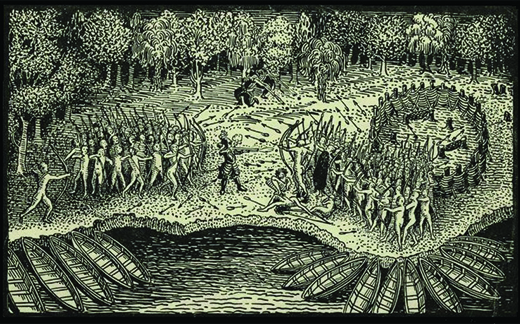| << Chapter < Page | Chapter >> Page > |
In comparison to Catholic Spain, however, Protestant England remained a very weak imperial player in the early seventeenth century, with only a few infant colonies in the Americas in the early 1600s. The English never found treasure equal to that of the Aztec city of Tenochtitlán, and England did not quickly grow rich from its small American outposts. The English colonies also differed from each other; Barbados and Virginia had a decidedly commercial orientation from the start, while the Puritan colonies of New England were intensely religious at their inception. All English settlements in America, however, marked the increasingly important role of England in the Atlantic World.
Spanish exploits in the New World whetted the appetite of other would-be imperial powers, including France. Like Spain, France was a Catholic nation and committed to expanding Catholicism around the globe. In the early sixteenth century, it joined the race to explore the New World and exploit the resources of the Western Hemisphere. Navigator Jacques Cartier claimed northern North America for France, naming the area New France. From 1534 to 1541, he made three voyages of discovery on the Gulf of St. Lawrence and the St. Lawrence River. Like other explorers, Cartier made exaggerated claims of mineral wealth in America, but he was unable to send great riches back to France. Due to resistance from the native peoples as well as his own lack of planning, he could not establish a permanent settlement in North America.
Explorer Samuel de Champlain occupies a special place in the history of the Atlantic World for his role in establishing the French presence in the New World. Champlain explored the Caribbean in 1601 and then the coast of New England in 1603 before traveling farther north. In 1608 he founded Quebec, and he made numerous Atlantic crossings as he worked tirelessly to promote New France. Unlike other imperial powers, France—through Champlain’s efforts—fostered especially good relationships with native peoples, paving the way for French exploration further into the continent: around the Great Lakes, around Hudson Bay, and eventually to the Mississippi. Champlain made an alliance with the Huron confederacy and the Algonquins and agreed to fight with them against their enemy, the Iroquois ( [link] ).

The French were primarily interested in establishing commercially viable colonial outposts, and to that end, they created extensive trading networks in New France. These networks relied on native hunters to harvest furs, especially beaver pelts, and to exchange these items for French glass beads and other trade goods. (French fashion at the time favored broad-brimmed hats trimmed in beaver fur, so French traders had a ready market for their North American goods.) The French also dreamed of replicating the wealth of Spain by colonizing the tropical zones. After Spanish control of the Caribbean began to weaken, the French turned their attention to small islands in the West Indies, and by 1635 they had colonized two, Guadeloupe and Martinique. Though it lagged far behind Spain, France now boasted its own West Indian colonies. Both islands became lucrative sugar plantation sites that turned a profit for French planters by relying on African slave labor.

Notification Switch
Would you like to follow the 'U.s. history' conversation and receive update notifications?